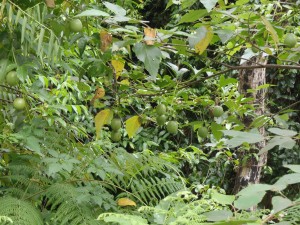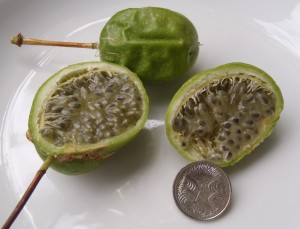Now, there are very few people from experience that don’t like eating Passionfruits in some form or another. Common, easy to grow and sweet, these relatively thirsty climbers have been grown by households in Australia for a long time.
When you go to acquire an edible Passionfruit plant in Australia you have a few main options; the variety â Black, Panama, Banana, and whether it is grafted or un-grafted. First available in the season are the grafted var’s as the non-grafted take a little longer to get going. You may be wondering… whats the real difference?

I personally avoid buying grafted Passionfruits as the rootstock used is from an exceptionally weedy Passionfruit variety from South America called Passiflora caerulea. The reasons given for its use as a rootstock is that it is cold-hardy and disease resistant, but it also readily sends sub-surface runners and shoots out which have to be constantly kept back or it will quickly overtake the top of the graft (desirable bit) and probably a lot more of your yard! Vigorous to the point that it will smother vegetation in yard and bush alike, it also produces natural cyanide in its stems, leaves and immature fruits so don’t let livestock or other animals (incl. children) eat it either.
I feel that part of the reason Blue Passionfruit is so frequently used as rootstock may be that a single plant will produce 1000 plants for grafting onto due to its running habit and that saves money, effort and time growing 1000 whole other rootstock plants as grafting fodder.
If you live in an area like Victoria or inland that has much colder periods of the year, the

Blue grafted varieties may be right for you. The rootstock being a bit less excessively-vigorous in the cool but you’ll still need to keep an eye on those runners as it can still be a weed in these areas. Possibly growing these in a container may help you to restrict much of this unwanted spread.
If you live in an area classed as warm-temperate, subtropical through to the tropics you’ll be able to grow non-grafted Passionfruit quite easily and with much less maintenance. The trouble more seems to be keeping water up to them in a low input system. Ie; minimal fertilisation, watering etc. tending to do much better in a partially sheltered understorey situation.

The main basis for this post is that i’m growing a native Passionfruit (Passiflora herbertiana) which is a bushfood local to the NSW east coast and ranges, into Queensland. The fruit itself is small, edible and sweet but has a distinct aftertaste. I havn’t heard of anybody trying this but I wonder if using this native species as a rootstock could reduce the relatively high water requirements of the cultivated Passionfruit varieties. At least for the areas where the native has natural distribution. I believe Passiflora herbertiana is not as cold hardy as Blue Passionfruit but having evolved in an arid country like Australia I assume it is more ably adapted to drought and minimal irrigation. Also the risk of it taking over or becoming an environmental weed is about zero.
Currently just an idea, if you’re reading this and have any input or thoughts I’d greatly appreciate the discussion. 🙂

Thanks for the background on the grafted vs non-grafted versions. I’m intending to grow passionfruit along the pergola on the side of my house and I hadn’t heard about the natural cyanide feature of the Passiflora caerulea. I don’t want anything potentially poisonous around when I have a 2 year old.
At last it is a reassurance to come across someone else who is concerned with the environmental risks posed by the root stock of the Nellie Kelly passionfruit. I live in Tasmania and am, after 5 years still trying to eradicate the invasive root stock vine that I constantly discover sending new shoots through my garden. In places it has reached to the top of a gum tree before I discovered it, and has rapidly grown to a thickness of one inch in diameter. It has , as yet not escaped into the nearby bushland as I have found and removed it before it could flower. This is not the case where I see it having taken over large tracts of bushland in gullies , creek beds etc around Hobart where it appears to be no one’s responsibility to address the problem. It should be classified as a noxious weed and plant nurseries prohibited from selling it. Nellie Kelly produce a non-grafted stock and , as the author rightly says, an alternative root stock should be found that is benign.
Hi, just wondering can you cut off the grafted vine.
If you did, you would have to redevelop roots from the scion (top half) to replace it and it is unlikely to happen before the vine dies off. It would be much more feasible to just buy a new ungrafted or alternatively grafted Passionfruit.
I have a grafted Nellie Kelly any you guys have me worried! It’s been in the ground for 1 year, no suckers as yet.. Should I dig it up, our will that make it worse??
I would remove as soon as possible. Go wide with your digging and try not to leave any fine, almost white, roots/rhizomes.
Its a pity but count yourself lucky if it hasn’t yet gone anywhere!
No, as it is the bottom half that goes into the ground that you want to get rid of.
Unless you are growing in a container. Consider it suicide to grow a grafted passionfruit. I have one in my frontyard and one in my backyard. Both send subterranean runners that pop up everywhere. I have runners as much as 5m away. My lawn is infected and if i dont mow for a week, there are numerous vines growing out of it. It has invaded my neighbours to the point i avoid talking to them. The only remedy i am planning is to kill the main vine and then target any vines which pop up everywhere by wearing a cloth glove, spraying poison and touching every vine which pokes up. Essentially starving the subterranean plant. Hard work and a weekly task, but has to be done.
Thank you so much for this information. I couldn’t understand why my Nellie Kelly was slowly doing ok’ish (in hot central Vic) but something else resembling a different type of passionfruit vine was doing sooo much better in the same pot … and now thanks to your post have found the culprit. I might take the suggestions here and remove it altogether in case the roots escape the pot. It already has taken over a neighbouring bush and seems to grow overnight. Thanks again
Hello. The reason I am searching this topic is because I have baby passionfruit coming up all over the place from an un tended vine ( the fruit mostly ended up on the ground). The are growing from the nelly kelly seed in small bunches with the broken down shell still around them. Not wanting to waste them , I wanted to find out if they could be potted up and planted out in n more appropriate positions and if they would bare fruit as they would of course be un grafted. I think I have my answer and will save them all!
Oh no I’ve just planted one of these and yes within a couple of months it has grown over the trellis and is starting to peer its head over the fence… hearing about the roots on this one i’m going to remove it. I lived in a house that had mint growing in the garden and had no idea how noxious it was with its root system I don’t want that same experience again!!!! Thanks for the info xx
I have the p. Herbertiana growing nearby. I am just about to ferment some seeds, if you want any. Yes, they taste pretty funky. I will try grafting.
Interesting reading especially after spending a ridiculous amount of time trying to eliminate the unwanted runners. We have no passionfruit but our trees and the neighbours are covered with the vine. I have tried 2 different poisons (using a surfactant with Corky passionfruit elsewhere) but so far unsuccessful. Any suggestions?